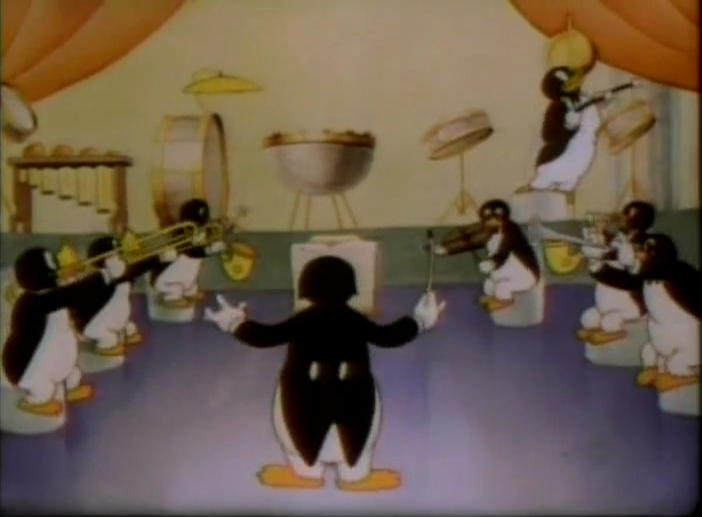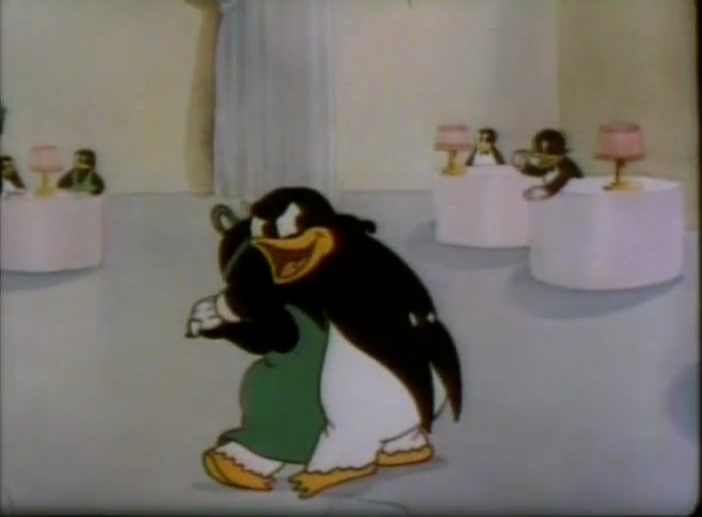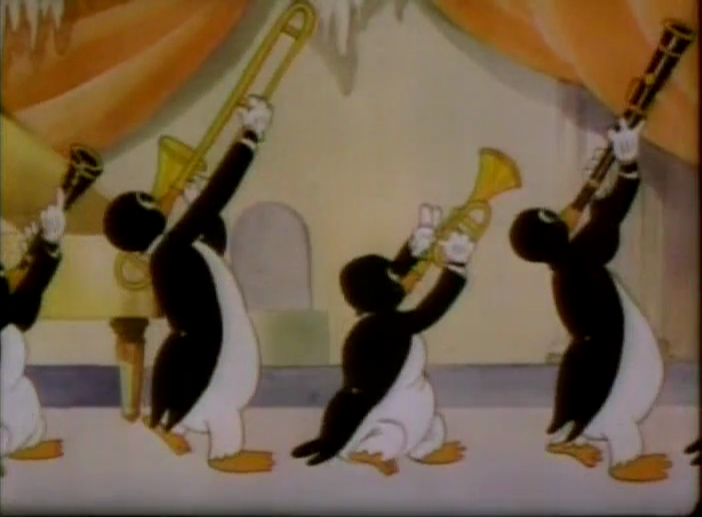RELEASE DATE: April 23, 1938 (according to the Big Cartoon Database)
DVD/BLU-RAY AVAILABILITY:
none at presentAn adequate version of this cartoon may be viewed HERE.
The cartoons of the Fred Avery unit at Leon Schlesinger's studio were, by 1938, among the plottiest animated shorts in Hollywood. Avery's rejection of the Walt Disney ethos included a strong belief in the power of a persuasive narrative.
Not for him was the plotless pageantry of Disney's Silly Symphonies, which did stress narratives, as the 1930s progressed, but often lost themselves in an ooh-aah tableaux format. (They will begin to show an Avery influence in this year--irony duly noted.)
As we've often groused here before, Disney's high-gloss, all-technique-no-soul policy had a negative effect on the American animated cartoon--particularly after 1935, when most animation studios produced upscale color films. With the emphasis away from character, story and, of course, HUMOR, mid-'30s American animation is a dismal low point for the popular art form.
Avery was the Disney Way's fiercest, most vocal opponent. Unlike many critics, he had a counter-offer that he took into action. Through the two dozen cartoons we've perused here, to date, we see Avery's persistent vision sometimes compromised by the front office, but always in evidence. In the weakest of his early cartoons, as in his milestone films, Avery strives to cram as much narrative as coherence will allow. They may have often been dumb storylines, but they followed through, and left the viewer with the sense that they'd seen SOMETHING, no matter how ill-advised.
With his 24th cartoon, Avery turns the tables on himself. He abandons the nagging need for a through-story, and riffs off the potential of a clever, unique setting. The result is a cartoon that exudes joy, motion and twisted good cheer.The title card tells a small lie of exclusion. "The Penguin Parade" was co-written with Richard Whiting, one of the major contributors to the American Songbook (AKA standards):
The song's July, 1937 copyright might suggest that it was composed for Avery's cartoon. I cannot find an instance of its use in a live-action film, nor its publication as popular sheet music. It's a slight song, and Avery uses as little as possible in his plot-free cartoon.
The Northern Lights create a cute visual metaphor for the Hollywood glitz of klieg lights and its accordant hoopla.
In the world of cartoon logic, it makes perfect sense that, in a 1938 cartoon version of the Antarctic, penguins and walruses would open a theme nightclub, have electricity, alcohol, linen service, et al.
Avery wastes no time peppering sight gags, including this long-time favorite:
A console-top pre-war fridge makes a perfect polar taxicab. We will follow its rider's path from coach to table.
Avery's style of drawing is writ large in the compact, Art Deco-tinged design of the many penguins that populate this picture.
Once inside, this penguin is voiced by Mel Blanc. He must have done something right! Said penguin waddles up to the walrus barkeep...
Customer's order: "Gimme a scotch an' soda, and a pinch of lemon."
In a comic sequence worthy of Jacques Tati, bartender does as told, with the consumer his own vessel.
Latin ditty with muted trumpet provides barkeep with fine shaking rhythm...
...and subject, now animated by Irv Spence, is pleasantly smashed. Now that's service!
Subject hiccups and weaves his way to a table, where a Tex Avery-voiced walrus awaits his confidence.Avery loved to use pop-culture references that his moviegoing audiences would easily get. Thus, he raided radio for material--not to mention current motion pictures. Here, a gag from a George Burns/Gracie Allen routine is given new life--again bolstered by Spence's sweet sketching:**
Walrus can't wait to tell his no-doubt racy story about "the two old mules in the army." Amidst tears of laughter and magnificent head-rearing gales, he whispers the joke, in installments, to his smashed pal:
Irv Spence's animation is a beautiful set-piece of drawn acting. The subtle changes in the penguin's face capture his drunkenness, that he is struggling to keep up with the walrus' story, and that he's engaged by this sudden friend. It's quality of the level not expected from such a simple, knockabout cartoon.
Story reaches conclusion; both parties convulse in joy...
Echoing a Gracie Allen line, plastered penguin confesses: "I don't get it."
And he thinks about that punchline: why is it supposed to be funny?
Penguin never gets to the finish line with that joke. Lights dim, and another grand radio appropriation--performed by its originator, comedian Cliff Nazarro, who did this stunning mile-a-minute double-talk bit on Jack Benny's mega-popular program:
A multiplane pan establishes a new subdued night-spot atmosphere--
and reminds us that baby, it's cold inside:
Nazzaro's breathless motormouth routine defies transcription. As others have noted, he salts the non-stop nonsense with names of key Schlesinger studio office personnel. All the animator need to is supply reasonable-looking gestures that create the illusion of normalcy.The grand show-biz gesture again cements the impression that what he said must make sense, somewhere, somehow.
Curtains (and Avery loves curtains) part to
reveal a sub-Busby Berkeley visual spectacle:
The obligatory overhead shot--a Berkeley fixture--is incurred. Avery still has a predilection for unusual viewpoints (a trait he will wean himself of by 1944)...reveal a sub-Busby Berkeley visual spectacle:
...but his unit did such shots very well, with a solidity that Frank Tashlin couldn't yet match.
Avery, throughout his career, loves to set up anticipation, then trash it. We, the audience, have every expectation, due to the music, camera angles, and time spent on this sequence, that we're gonna see something. Instead, we get this:
We are seeing something new--an Art Deco orgy of stylized symmetry, built around another of Avery's Chaplin-in-a-milk bottle gag concepts.
The routine fails, as the background music grows flaccid and discordant.
A quick save makes this fiasco applause-worthy.
And a succession of violently-colored curtains fall, one in front of another, in one of Avery's signature moments. The dry cleaning bills in Avery's world must be enormous!Our fourth-dimensional emcee returns with more patter, after a delighted audience pays tribute to the curtains.
More double, triple and quadruple talk flows from Nazzaro's lips like spring water from a mountain creek.
A crooner, and his vocal trio, are apparently introduced. Quasi-Crosby moos the always-agreeable "When My Dreamboat Comes Home"--one of Carl Stallings' old standbys.
KFWB is a real radio station with ties to the Warner Brothers studio, and has broadcast since 1925. More info HERE. A general notion of the Schlesinger cartoons are soft self-plugs, and KFWB shows up in other WB cartoons of the era. Poor KFWB has become a sports talk station--perhaps the worst fate possible for a broadcasting venue. But we digress...
Stallings' arrangement of "Dreamboat" has intrusive, stabbing brass riffs, and Avery cuts away to visually dynamic orchestral shots as the score demands.
More fine animated acting as this sorta-Bing oozes his way around the KFWB mike, finally embracing it as if to make love with it.
Instead, crooner introduces his trio, who assay a hopped-up late '30s jive version of the song. This forced manner of singing is as dated as a 1989 heavy metal guitar riff.
They're a cheerful (and economical) lot, this drawn-once, duplicated-twice group.
They anticipate the finest moment of their routine, when the music stops for four seconds:
One image sums up a director's vision: to entertain (and annoy) the audience, and to burst the delicate bubble of trust that allows our suspension of disbelief.
Another Tati-esque cutaway gag, impeccably timed to the musical beat:
Satisfied that his bow tie makes a successful wiper blade, sloppy joe continues his symphony in tomato.
The finale of this cartoon appears to be a rare example of Avery being influenced by other cartoons. Hugh Harman and Rudolf Ising's unit at M-G-M (which Avery would, all too soon, supplant) had lavish budgets and a desire to outdo their former employer, Walt Disney, at Technicolor razzle-dazzle. They occasionally allowed a sense of humor into their cartoons. Swing Wedding, released in 1937, still flummoxes viewers with its psychotic energy and its boldly racist imagery. Its finale of jazz madness and orchestral anarchy is, for my money, the wildest moment in Hollywood cartoon history.Avery's version, in comparison, is far more measured, but he seems influenced by Harman-Ising's temporary breach of sanity, good taste and decorum. For your dancing and dining pleasure, here are some representative screen-grabs of Swing Wedding, which you can watch at the hyperlink above: Er... back to our regularly scheduled programming.
The penguin band decides to heat things up and get the frigid joint jumpin'.
Avery will never allow that Swing Wedding vulgarity--that loose-limbed, wild-thrashing chaos--into his work. His main focus, from now until his move to M-G-M in late 1941, is the consistent increase of tempo. Avery's is a clean, crisp, modern vision, and a comparison of Penguin Parade's jazz-orgy and Swing Wedding's says a great deal about his decorum and control as a film-maker and comedian.
The clarinet player takes a charming and well-timed baton-spin of his instrument as he solos.
As the percussionist abandons his stage-left post, the ork's energy level sags.
Drummer boy revives the band.
Some more Irv Spence animation? Yes, please.
Bandleader endows groggy bassist with hot-foot of rhythm.
Our next bit of business comes from the recent Samuel Goldwyn live-action smash Dead End--a film that thoroughly replicated the Warner Brothers look-and-feel. Out of the mouths of one of the Dead End Kids--the poor schlubs who would portray street hoodlums well into their '40s--come these immortal lines:
"Hey, look, fellas, I'm dan-cin'. Look--I'm dan-cin'."
A labeled gag shows Avery's methodical approach to anarchy. The walrus pianist's hot playing causes his grand piano to melt...
...and morph into a more apropos bar-room upright.
A final sight-gag cutaway will be re-used in Avery's celebrity-caricature cartoon Hollywood Steps Out (1941).
The minor-key swing of "Bei Mir Bist du Schoen" becomes a stale parade march of "The Merry Go Round Broke Down," just to throw the audience off a bit.
Then we're back to riffs and contra-riffs, as the red-hot music reaches climax.
A diagrammatic metaphor--which seems like something Chuck Jones would use in the 1950s--steals our attention.
Rapid cross cuts signal that the band is about to shoot its musical load:
A double-exposure is as wild as it gets here.
As sheet music flies around the ballroom, the musicians come to a halt and address us, en masse:
"If you people out there in the audience
think we're gonna keep this up all night..."
think we're gonna keep this up all night..."
"you're screwy..."
"and we do... mean... YOU."
With a general look of sadness, the weary band dismantles...
and we iris out.
Though no masterpiece, The Penguin Parade further cements Avery's polar (no pun intended) position as entertainer and innovator. This early on, Avery understood that it paid to play his cards close to his chest. To not call attention to the outrageous made it more effective. Despite my love for Swing Wedding, I recognize that its approach, which calls great attention to its flamboyant chaos, is regressive and crude.
As said, a comparison-viewing of these cartoons can create a greater understanding of how much Avery and his unit achieved with their droll approach to animated mayhem.
_______________________As said, a comparison-viewing of these cartoons can create a greater understanding of how much Avery and his unit achieved with their droll approach to animated mayhem.
*** As ever, many thanks to radio/voice artist expert Keith Scott for providing the straight dope on who-did-what, as well as where it came from. Keith, you put Google Search to shame! You're a brick!
UP NEXT: A true game-changer for American animation--and not necessarily for the better.






















































































































































































The penguins at the end of the cartoon are doing a salute to Jimmy Fidler's Hollywood News of the 1930s. He usually signed off with: "Goodnight to you, and I do mean YOU!" Keep up the great work on this Avery series, Frank, even though I don't agree with you on 1930s animation.
ReplyDeleteMark, thank you kindly for a helpful and thoughtful reply. It should be clear that I love pre-1935 sound cartoons, for their imagination, spirit and joie de vivre. I am not a Disney fan, as should be obvious. Aside from a handful of shorts and two or three of the features, Disney's work does nothing for me. I admire its craft and artistry, but it seems to me that what Lantz, Fleischer, Mintz or other smaller studios did, at the same time, has far more enjoyment, pep and entertainment value. The best of these cartoons will never lose their power to delight and confound. Disney's work usually does neither for me.
ReplyDeleteI hope that clarifies my feelings on 1930s animation. In any case, I admire your gentility in allowing me to have an opinion, and not damning me for speaking my mind. You are a gentleman and a scholar--and a hell of a good animator.
Those Disney cartoons from the same period are impressive to look at, but they don't offer many surprises. Harman and Ising had the big budgets to compete with Disney at the same game. Warner Bros. didn't, and came out with cut-rate knockoffs like "Pop Goes Your Heart." Avery was the guy who led the charge AWAY from Disney 's influence. He realized that with Disney setting and meeting audience expectations of what a cartoon should be, the way to stand out was to defy those expectations. Disney would've played this cartoon straight, with lavish animation and glistening icicles and penguins dancing...you wouldn't find sight gags, wild jazz or pop culture references like Avery put in it.
ReplyDeleteCoincidentally, since at least "Aladdin" (1992), Disney's been playing around with the WB influence (and in "The Emporer's New Groove" in 2000 went ultra-beserk with it,to the exclusion of anyone recognizing the Disney staff's involvement...)
ReplyDeleteAnd yet ironically, Avery with "The Mice Will Play", if with the forthcoming WB style that the entire industry (Jay Ward and Hanna-Barbera on television still to come) began using, did a semi-cute cartoon yet with his jokes and well.
I always wondered who Byron Gay was. He's credited with writing the song (like Warren and Dubin and before Ruby and Kalmar) but this is his own songwriting credit onscreen for the cartoons and I can't find any info on him.SC